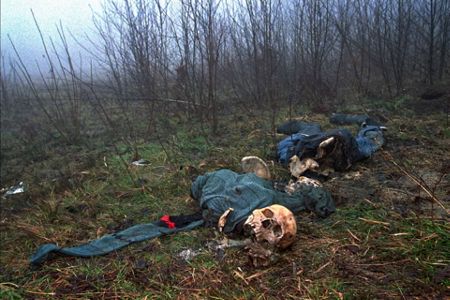The Massacre.
The Dutch battalion (Dutchbat) of UNPROFOR had set up its headquarters in an abandoned factory in Potočari. More than 20,000 refugees from Srebrenica sought their protection. Dutchbat admitted some of the elderly, women, and children together with a few hundred younger men before claiming that their base was full and stranding thousands outside the gates. Some of you may remember photos like this one (from the UK Telegraph):.

The Serbs then began operating in a familiar pattern. They started by separating men and boys from their families promising that the women and children would be relocated to safer areas. Subsequent testimony by survivors indicated that often, Mladić would assure captives that they would be treated as prisoners of war and would be exchanged for other prisoners. In truth, nearly all of the Bosnians who were captured were killed. Although there were sporadic executions of small groups and individuals on the eleventh and twelfth of July, the Serbs began a series of mass executions on the thirteenth of that month.
The mass executions also followed a well-established pattern. The men were first taken to empty schools or warehouses. After being detained there for some hours, they were loaded onto buses or trucks and taken to another site for execution. Usually, the execution fields were in isolated locations and the men were taken off the trucks in small groups, lined up and shot.
The murderers were cagey enough not to hold the executions in a single place. Rather, they spread them out over the region executing men in groups as small as 15 to 20 but sometimes in groups as large as several hundred. Victims’ bodies have been discovered in the Jadar River, the Cerska River valley, a warehouse in Kravica, the town of Tišća, a school in Orahovac, and another school in Petkovići. This geography is but a partial list.
Usually the bodies were dumped and buried in mass graves although occasionally, bodies would simply be thrown in a river or left to rot in place.

[Photo from spectrumlocalnews.com.]
Not all of the victims have been identified or discovered. The likelihood is that some never will be. What is known to date is that over a period of about 4 days Serbian forces murdered more than 8,000 Bosniak civilians. The website Polynational War Memorial reports that the Preliminary List of People Missing or Killed in Srebrenica enumerates 8,372 individuals. You can see some of their faces at this website.
I will add one last thought because most of us are inclined to limit our thinking of genocide to mass murder. But we need to keep in mind that genocide has goals beyond killing people. Genocide wants to kill history. Before the Serbian genocide, Srebrenica, where the population was 75 percent Muslim, had five mosques. The Serbians burned all five. When some Bosniaks returned, all they found were charred strips of land where their houses of worship once stood. It was as though the Serbs wanted not only to erase the current population but to erase their history in that place as well.
The genocide was mostly successful in its effort to rid the area of Bosnian Muslims. It succeeded because Srebrenica and the surrounding area are now part of the Republika Srpska. It succeeded because the population has fallen from 36,000 in 1991 to just more than 13,000 in 2013. It succeeded because, of the 23,000 people no longer in Srebrenica, more than 20,000 are Bosniaks. As of the recently published results of the 2013 census, only 54 percent of the people – down from more than 75 percent – are Bosniaks.
(A few words about terminology: Some of you might hear or read some terms referring to participants in these atrocities that one faction or another sees as particularly derogatory. These are Četnik [Chetnik], Ustaše [Ustasha], and Mujahedeen. I’ve tried to avoid using them because they are weighted with more history than even I care to discuss or research and because they are typically used reflexively with the intent of vilifying an entire ethnic group rather than individual executioners.
All three ethnic groups were guilty of atrocities during these wars and the side being victimized would often use one of these labels to demonize the perpetrators. Americans who are knowledgeable about U S and Soviet involvement in Afghanistan are probably familiar in some measure with the term Mujahedeen. In this case, it refers to non-Bosnian Muslim fighters who came to the fight on the Bosniak side in the nineties. The Ustaše, as I noted in a previous entry, were a Nazi puppet regime that held power in Croatia during the Second World War. Many historians view them as even more vicious, bloodthirsty, and murderous than the Nazis themselves. Finally, the Četniks are a Serbian nationalist movement that has its roots in World War One. Like Karadžić and Mladić, they envision a “Greater Serbia” that should be, as they stated in a 1941 declaration, “ethnically pure and is to include Serbia, Montenegro, Bosnia and Herzegovina, Srijem, the Banat, and Bačka.”
This is all I’ll say on the matter. If you are interested in learning more, you’re on your own.)